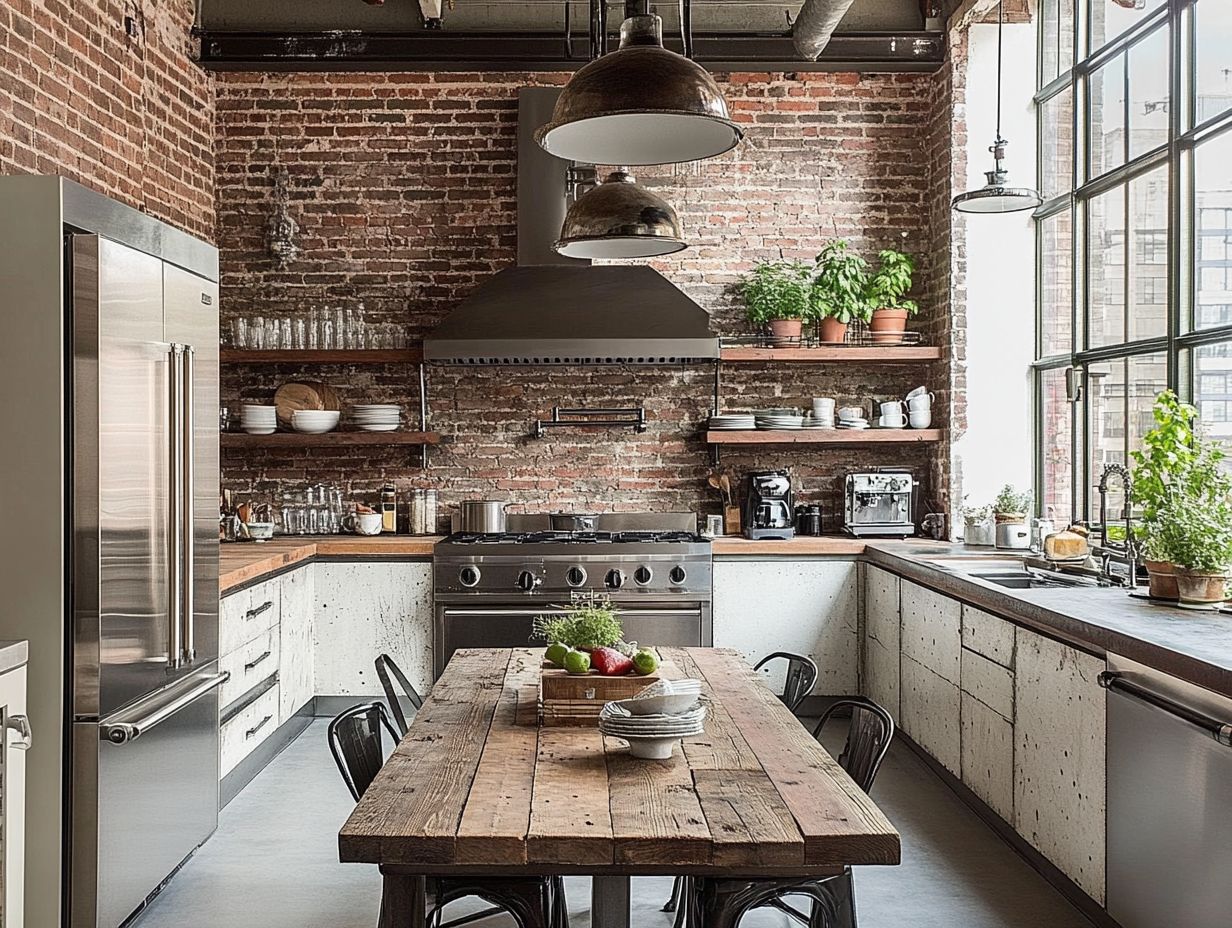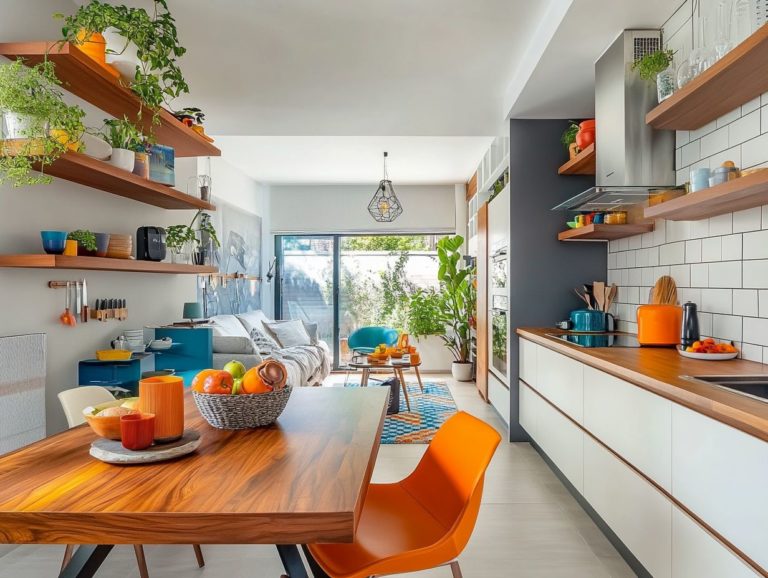Choosing Materials for an Industrial-Style Kitchen
Creating an industrial-style kitchen revolves around striking the perfect balance between look and functionality.
As you embark on this design journey, keep in mind several key factors when selecting materials that elevate your space while enduring the test of time. From the rugged charm of reclaimed wood to the sleek allure of stainless steel, every choice you make influences your kitchen’s overall vibe.
Get ready to explore essential considerations that will help you design your dream kitchen! This guide will recommend standout materials and provide tips on mixing them to achieve a cohesive, stylish finish.
Jump in now and let’s create your industrial kitchen masterpiece together!
Contents
- Key Takeaways:
- Defining the Style
- Factors to Consider when Choosing Materials
- Recommended Materials for an Industrial-Style Kitchen
- Combining Materials for a Cohesive Look
- Frequently Asked Questions
- What types of materials should I consider when choosing an industrial-style kitchen?
- What are the benefits of using concrete in an industrial-style kitchen?
- Is stainless steel a good choice for an industrial-style kitchen?
- How can I incorporate brick into my industrial-style kitchen?
- Why is reclaimed wood a good choice for an industrial-style kitchen?
- What are some ways to incorporate exposed metal in an industrial-style kitchen?
Key Takeaways:

- Prioritize durability and functionality when choosing materials for an industrial-style kitchen.
- Consider the cost and maintenance requirements of materials to ensure they align with your budget and lifestyle.
- Mix and match recommended materials such as metal, concrete, reclaimed wood, exposed brick, and stainless steel for a cohesive industrial look.
Defining the Style
The urban industrial style, a design trend that flourished in the 20th century, combines the rugged allure of raw materials with modern functionality. This creates a distinctive atmosphere in spaces like industrial-style kitchens.
You’ll notice elements such as exposed bricks, metal finishes, and wooden beams. Each plays a crucial role in embodying a sense of organized chaos.
This approach ensures that every component contributes to a cohesive visual narrative, inviting you to experience a space that speaks volumes about character and creativity.
Factors to Consider when Choosing Materials
When designing an industrial-style kitchen, it’s crucial to consider a variety of factors. Your chosen materials should reflect your desired style and fulfill practical requirements.
Durability and functionality are paramount when selecting materials like stainless steel and cement finishes.
Keep an eye on cost and maintenance to create a kitchen that remains not just beautiful, but user-friendly for years to come.
Durability and Functionality
Durability and functionality are essential in your industrial-style kitchen. The choice of materials—think raw materials and stainless steel—directly influences both performance and longevity.
Prioritizing robust materials ensures that your space can endure the demands of daily use without sacrificing visual appeal. Stainless steel, in particular, provides an outstanding combination of strength and corrosion resistance, making it perfect for surfaces that regularly face heat and spills.
Selecting high-quality industrial appliances boosts efficiency and reduces downtime, facilitating smooth operations.
Every detail—from countertops to cabinetry—plays a crucial role in crafting an environment that satisfies both aesthetic desires and practical needs, ultimately enhancing your entire culinary experience.
Cost and Maintenance
Understanding the cost and maintenance of materials is essential when designing an industrial-style kitchen. This knowledge directly influences your budget and the usability of the space.
The materials you choose should align with your aesthetic vision and support the daily functionality expected in a busy kitchen environment.
For instance, opting for stainless steel surfaces can be a smart move, striking that perfect balance between durability and visual appeal while making upkeep a breeze.
On the flip side, selecting high-maintenance materials could lead to unexpected costs, throwing a wrench in your financial planning.
Therefore, when selecting industrial cabinets, consider options like reclaimed wood or laminate finishes. These choices blend style with cost-effectiveness, ensuring that your kitchen remains inviting and easy to maintain.
Compatibility with Industrial Style

Compatibility with the industrial style is crucial for your materials. This style combines different design elements, including neutral colors and metal finishes.
To achieve visual coherence, lean towards raw materials like exposed brick and reclaimed wood. Polished concrete surfaces are also excellent choices.
Furniture with metal frames, such as steel coffee tables or iron shelving, can enhance your space. Vintage lighting fixtures and distressed leather add to the industrial vibe.
Choosing simple patterns in muted tones for textiles ensures a harmonious look. They should complement the metallic and wooden textures already in play.
Curating these materials transforms your spaces into appealing environments. You’ll enjoy the rewarding experience of maintaining compatibility with the industrial style.
Recommended Materials for an Industrial-Style Kitchen
Designing an industrial-style kitchen? Certain materials stand out for their functionality and durability.
Consider these materials:
- Metal surfaces
- Polished concrete
- Reclaimed wood accents
- Exposed brick walls
- Stainless steel appliances
These elements create that quintessential industrial vibe. They result in a cohesive yet dynamic space that showcases the charm of raw materials.
Metal
Metal is essential in your industrial-style kitchen. It serves practical purposes for appliances and cabinets while making a bold design statement.
Stainless steel countertops offer durability and easy maintenance. They also elevate the kitchen’s visual appeal.
Wrought iron shelves enhance both functionality and style, adding a rustic touch. Aluminum accents provide a lightweight contrast to heavier elements.
Copper details, like pot racks or handles, introduce warmth and character. Galvanized steel adds a utilitarian edge, completing the look.
Incorporating these materials transforms practical tools into stylish accessories. They radiate a raw, urban charm that encapsulates the industrial motif.
Concrete
Concrete is a top choice for your industrial-style kitchen. Its durability and sleek appearance make it ideal for high-traffic areas.
Countertops, flooring, and backsplashes made of concrete withstand daily use. They ensure your kitchen remains functional and stylish.
With various finishes, from glazed to matte, concrete easily complements your design vision. It blends well with materials like wood or metal.
Concrete’s low-maintenance nature enhances longevity when sealed properly. It’s a practical choice for anyone investing in their culinary oasis.
Reclaimed Wood
Reclaimed wood brings warmth and character to industrial-style kitchens. Its rustic grey tones work well for kitchen islands and vintage decor.
This material’s rich textures create a striking contrast against metal and concrete. It elevates the overall aesthetic appeal.
Choosing reclaimed wood reflects a commitment to sustainability. It repurposes materials that would otherwise go to landfills.
Reclaimed wood can be used in cabinetry, shelving, accent walls, and dining tables. It transforms any space into a fusion of modern sophistication and timeless charm.
Exposed Brick

Exposed brick is a key feature of industrial kitchen design. It instantly brings character and authenticity to your space.
Its rough texture and warm tones create a striking contrast with sleek stainless steel appliances and polished countertops, allowing you to achieve a harmonious balance between rustic charm and modern functionality.
This material not only adds visual interest but also enhances the kitchen’s durability, providing a sturdy backdrop that can withstand the demands of daily life.
Exposed brick effectively absorbs sound, creating a quieter cooking environment.
It integrates effortlessly with features like open shelving and pendant lighting, making it a critical choice for anyone eager to embrace the bold, functional aesthetic of industrial design.
Stainless Steel
Stainless steel is more than just a durable choice; it’s an essential feature in industrial kitchens. Commonly found in appliances and modern finishes, it greatly enhances functionality.
This material shines due to its impressive resistance to corrosion and staining. It’s perfect for busy environments where cleanliness is crucial and appeals to both chefs and their patrons.
Its versatility allows for seamless integration into a variety of designs, from bustling commercial kitchens to trendy eateries, delivering both efficiency and a polished appearance.
By opting for stainless steel, you ensure that your establishment boasts a long-lasting, attractive kitchen that satisfies both practical needs and stylistic aspirations.
Combining Materials for a Cohesive Look
Transform your kitchen into a stunning industrial masterpiece! Achieving a cohesive look requires a bold blend of materials that captures the essence of urban industrial design. By thoughtfully integrating elements like exposed brick, sleek metal finishes, and reclaimed wood, you can craft a visually captivating kitchen layout that is both functional and inviting, embodying the perfect balance of style and practicality.
Tips for Mixing and Matching Materials
Mixing and matching materials in your industrial-style kitchen calls for a thoughtful approach to achieve that cohesive look while still embodying the essence of the industrial aesthetic.
To blend different textures and finishes effectively, focus on incorporating elements like unfinished wood, brushed metals, and concrete surfaces.
Consider utilizing a dominant material as a base; stainless steel appliances, for instance, provide a sleek foundation that allows other layers to shine without overwhelming the space.
Imagine pairing an oak dining table with galvanized steel chairs; this creates a striking contrast. Adding warm textiles or vintage-inspired accessories can soften the overall aesthetic and invite a touch of warmth.
By emphasizing a balance between rugged and refined finishes, you ensure that your kitchen remains both functional and stylish, enhancing its intrinsic industrial charm.
Frequently Asked Questions
What types of materials should I consider when choosing an industrial-style kitchen?

Consider options like concrete, stainless steel, brick, reclaimed wood, and exposed metal. These materials add a raw and rugged look to the space, characteristic of industrial design.
What are the benefits of using concrete in an industrial-style kitchen?
Concrete shines in an industrial kitchen, perfect for everything from countertops to flooring. It is a durable and versatile material, resistant to heat and scratches, with a unique modern look that enhances the industrial aesthetic.
Is stainless steel a good choice for an industrial-style kitchen?
Yes, stainless steel is a popular material for industrial-style kitchens due to its durability, easy maintenance, and sleek appearance. It is often used for appliances, countertops, and backsplashes to add a touch of modernity to the space.
How can I incorporate brick into my industrial-style kitchen?
Imagine transforming your kitchen with the timeless charm of brick! This classic material shines in industrial design.
Use it for accent walls, flooring, or backsplashes. Brick adds texture and warmth while keeping that industrial vibe alive.
Why is reclaimed wood a good choice for an industrial-style kitchen?
Reclaimed wood is both sustainable and eco-friendly. This salvaged wood offers a rustic look that brings warmth and character to your kitchen.
What are some ways to incorporate exposed metal in an industrial-style kitchen?
Exposed metal, like pipes and light fixtures, is essential in industrial spaces. You can include it through open shelving, pendant lights, or as decorative accents.
Just balance it with other materials to maintain the right look.





